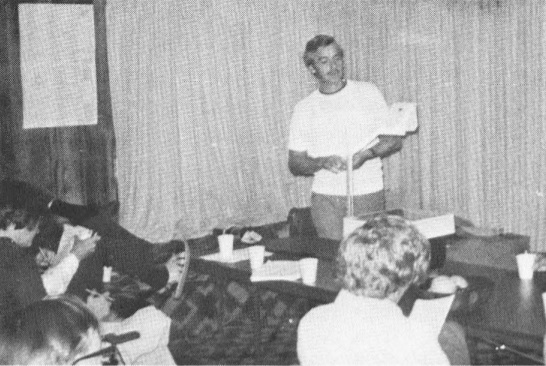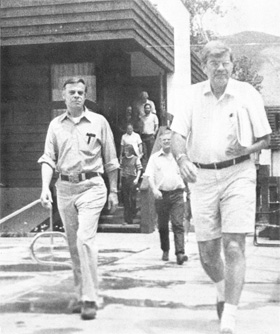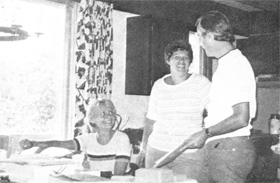Followup: Summer Study '77
"Extremely successful..." and "real progress was made." That's how James Walker summed up Summer Study V, a three-week seminar at Aspen, Colorado.
Walker, assistant head of Fermilab's colliding beams department, headed the study. From June 27 to July 15, 45 scientists applied their collective mental muscle to one challenge: laying groundwork for colliding beam experiments set for late 1980 at Fermilab.
Why do scientists want to collide proton beams head-on? Because, Walker says, such a crash will release great energies... and create particles existing when the universe was born.
He compared the anticipated discoveries to viewing exotic animals in a zoo millions of years old.
To collide beams, a twin to Fermilab's existing accelerator will be built in the Energy Doubler program. Beams will be accelerated in opposite directions around the four-mile main ring until scientists determine they should collide. The energy created will be up to 50 times greater than today's 500 billion electron volt accelerator.
Besides creating new fundamental knowledge of the universe, the project will provide other benefits One will be a 50 percent cut in the cost of electrical power for running the accelerator. The savings will result from superconducting magnets being built here--utilizing supercold (minus 450 degrees zero Fahrenheit) technology being developed on-site also.
"Summer Study '77 was felt to be particularly successful," Walker said, "because it focused exclusively on colliding beams and therefore significant progress was made in this area. We at the laboratory found it more productive because scientists' attention was geared to solving specific problems. Due to the concentrated effort, we know now much better how to assign our priorities.
"The study results will guide work to be done in the next six months to a year," Walker said. As the Energy Doubler is built, other construction will provide experimental areas and a detector facility.
1977 Summer Study marked the fifth time that scientists from Fermilab and invited scientists retired to the shadow of the Rockies to consider the world's next generation of high energy physics experiments. Previously -- in 1968, 1969, 1973, and 1976 -- summer studies were held in Aspen; the 1970 session met at Fermilab.
This year's study group was about evenly divided between staff persons and users/invited guests. Users represented 13 institutions and laboratories from across the United States. Other participants were from ERDA, National Science Foundation, CERN (Switzerland) and Center for Nuclear Studies, Saclay, France.
Before the study, participants were provided with latest publications on the topic. Also, study members will write an estimated 100 original papers (one to five each) on the seminar. Printed proceedings of the summer session are expected in about three months.
Summer Study '77 marked the first time that colliding beams was the featured topic. Last year, this topic shared the agenda with a general consideration of questions facing the high energy physics community.
The study was divided into two one-and-one-half week periods. About half the participants attended for a period; half for both periods.
Subtopics addressed at the conference were:
1. Use of the main ring accelerator beam for beam storage;
2. Methods to collide the main ring and Energy Doubler beams;
3. Detection schemes to study collisions;
4. Anti-proton production and cooling; and
5. General design concepts for experimental areas at interaction regions.
Discussion leaders, assigned to topics as listed above, were: Alvin Tollestrup, Fermilab; R. Diebold, Argonne National Laboratory; D. Hitlin, Stanford Linear Accelerator; P. Mcintyre, Harvard University; and D. Ayres, ANL.
Leaders opened each period with 60-minute presentations introducing their assigned topics and identifying areas for further study. The five subgroups then held daily work sessions. Results of their deliberations were reported by group leaders at 4 p.m. coffee and thought-sessions.
To conclude study periods, leaders presented hour-long summaries of work achieved. "These were at a particularly high level," Walker said. "They were quite outstanding reviews of the proceedings, remembered for their comprehensiveness, clarity and identification of major achievements and outlining of work remaining."
Highlighting the session was a roundtable discussion on colliding beam physics to be done at Fermilab. Joining three experimental physicists was a trio of theorists invited from the Aspen Center for Physics. The latter were John Rosner, University of Minnesota; Dick Slansky, Los Alamos Scientific Laboratory; and Lincoln Wolfenstein, Carnegie-Mellon University. The experimentalists were: James Cronin (Fermilab); Carlo Rubbia (Harvard); and Bob Diebold (ANL). A very lively discussion was held and helped to identify some of the physics potential of colliding beams at Fermilab.







